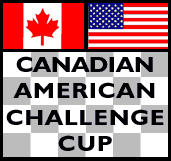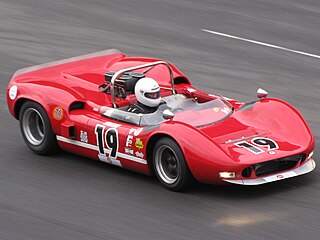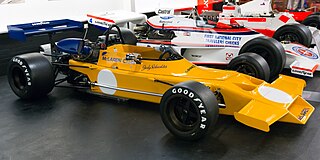Related Research Articles

The Ford GT40 is a high-performance endurance racing car commissioned by the Ford Motor Company. It grew out of the "Ford GT" project, an effort to compete in European long-distance sports car races, against Ferrari, which won the prestigious 24 Hours of Le Mans race from 1960 to 1965. Ford succeeded with the GT40, winning the 1966 through 1969 races.
McLaren Racing Limited is a British motor racing team based at the McLaren Technology Centre in Woking, Surrey, England. McLaren is best known as a Formula One constructor, the second oldest active team, and the second most successful Formula One team after Ferrari, having won 183 races, 12 Drivers' Championships and 8 Constructors' Championships. McLaren also has a history of competing in American open wheel racing, as both an entrant and a chassis constructor, and has won the Canadian-American Challenge Cup (Can-Am) sports car racing championship. The team is a subsidiary of the McLaren Group, which owns a majority of the team.
Power-to-weight ratio is a calculation commonly applied to engines and mobile power sources to enable the comparison of one unit or design to another. Power-to-weight ratio is a measurement of actual performance of any engine or power source. It is also used as a measurement of performance of a vehicle as a whole, with the engine's power output being divided by the weight of the vehicle, to give a metric that is independent of the vehicle's size. Power-to-weight is often quoted by manufacturers at the peak value, but the actual value may vary in use and variations will affect performance.

The Canadian-American Challenge Cup, or Can-Am, was an SCCA/CASC sports car racing series from 1966 to 1987.

Formula 5000 was an open wheel, single seater auto-racing formula that ran in different series in various regions around the world from 1968 to 1982. It was originally intended as a low-cost series aimed at open-wheel racing cars that no longer fit into any particular formula. The '5000' denomination comes from the maximum 5.0 litre engine capacity allowed in the cars, although many cars ran with smaller engines. Manufacturers included McLaren, Eagle, March, Lola, Lotus, Elfin, Matich and Chevron.
Chaparral Cars was a pioneering American automobile racing team and race car developer that engineered, built, and raced cars from 1963 through 1970. Founded in 1962 by American Formula One racers Hap Sharp and Jim Hall, it was named after the roadrunner, a fast-running ground cuckoo also known as a chaparral bird.

The McLaren M2B was the McLaren team's first Formula One racing car, used during the 1966 season. It was conceived in 1965 and preceded by the M2A development car. Designed by Robin Herd, the innovative but problematic Mallite material was used in its construction. The car was powered by Ford and Serenissima engines but both lacked power and suffered from reliability issues.

The McLaren M7A and its M7B, M7C and M7D variants were Formula One racing cars, built by McLaren and used in the world championship between 1968 and 1971. After two relatively unsuccessful years of Formula One competition, the M7A was used to score McLaren's first win at the 1968 Belgian Grand Prix.
The McLaren M4B was a Formula One racing car constructed by Trojan for Bruce McLaren Motor Racing and raced five times by New Zealander Bruce McLaren at the start of 1967.
The McLaren M18 is an open-wheel Formula 5000 racing car designed and made by McLaren in 1971.

The McLaren M8A was a race car developed by driver Bruce McLaren and his Bruce McLaren Motor Racing team for their entry in 1968 Can-Am season. The M8A and its successors dominated Can-Am racing for four consecutive Can-Am seasons, until the arrival of the Porsche 917.

The McLaren M4A was an open-wheel racing car designed by Robin Herd and built by British Formula One team McLaren to compete in the European Formula Two Championship.

The Cooper T60 is a Formula One racing car from the Cooper Car Company, which was used at events of this racing formula from 1962 to 1965.

The Brabham BT30 was a open-wheel Formula 2 racing car used in the 1969, 1970, and 1971 European Formula Two Championship.

The McLaren M22 is a open-wheel race car, designed and developed by McLaren, to compete in Formula 5000 racing in 1972. Like it predecessors, The McLaren M22 was manufactured in large numbers. Built close to the weight limit, it was very light and was powered by a 500+ hp Chevrolet V8 engine. The cars were not actually manufactured by McLaren itself, but by the British racing car manufacturer Trojan, as with previous models. This would turn out to be the last Trojan-built McLaren F5000 car.
The March 733 was a Formula 3 car built by March Engineering in 1973. Tony Brise won the 1973 Championship driving this car. It is powered by the 1.6 L (98 cu in) Ford Twin Cam straight-four engine.

The Brabham BT15 is a mid-engined open-wheel Formula 3 racing car, designed, developed, and built by Brabham between 1965 and 1966. 26 cars were built. It was powered by a naturally aspirated, 997 cc (60.8 cu in), Ford straight-four engine ; which was popular with Formula Ford racing at the time.

The McLaren M1A, and its derivatives, the McLaren M1B and the McLaren M1C, are a series of mid-engined Group 7 sports prototype race cars built by McLaren, between 1963 and 1968. The M1A was the team's first self-designed and developed sports car. Later versions, such as the 'M1B' and 'M1C', competed and raced in the North American Can-Am series, starting in 1966 season. The car was raced in North America and Europe in 1963 and 1964 in various Group 7 and United States Road Racing Championship series events. 24 examples of the M1A and M1B were built, and 25 examples of the M1C were manufactured. They were powered by a few different motors, including Chevrolet small-block engine, an Oldsmobile V8 engine, a Chevrolet big-block engine, and even a Ford FE engine. It was constructed out of a tubular space frame chassis, and, combined with its light weight of 551 kg (1,215 lb) this gave it a great power-to-weight ratio. The 4.5 L (270 cu in) Oldsmobile V8 engine developed around 310 hp (230 kW), while the 350 cu in (5.7 L) Chevrolet small-block V8 engine was capable of developing over 550 hp (410 kW), and 538 lb⋅ft (729 N⋅m) of torque. This drove the rear wheels through a Hewland L.G.400 four-speed manual transmission.

The McLaren M21 is an open-wheel race car, designed and developed by Australian designer Ralph Bellamy, and built by British constructor and racing team, McLaren, to compete in the European Formula Two Championship in 1972. It was designed to be lower, flatter, and squarer, and more aggressive in stance and design than its predecessor, with the monocoque being positioned, but still retained the regular front-and-rear outboard suspension.It was driven by South African Jody Scheckter. It won one race, at Crystal Palace in 1972, with Scheckter eventually finishing 8th-place in the championship, scoring 15 points. It, unfortunately, suffered numerous mechanical and technical problems, including engine failures and handling problems, which prevented it from winning more races. It was powered by either a naturally aspirated 1.6 L (98 cu in) Ford-Cosworth BDA four-cylinder engine, tuned to produce 210 hp (160 kW), or a larger bored-out 1.9 L (120 cu in) Ford-Cosworth BDF, tuned to develop 271 hp (202 kW).
The McLaren M25 was an open-wheel racing car, designed by John Barnard, and developed and built by British constructor McLaren in 1973. It was based on the successful McLaren M23 Formula One car. It was originally built with the intention to be a Formula 5000 car, but it did not compete in any F5000 races, and didn't even contest in a motor race until 1976, which by that, was too late, since Formula 5000 racing had folded. It then became a Formula One car for Emilio de Villota, and was equipped with a 3.0 L (180 cu in) Ford-Cosworth DFV V8 engine, where it only entered one World Championship Grand Prix, the 1978 Spanish Grand Prix. de Villota damaged the car in an accident during the practice session for the race, so the team reverted his car back to the M23.
References
- ↑ "List by Name – Bruce McLaren". Archived from the original on 2022-05-28. Retrieved 2022-06-18.
- ↑ "Formula A/5000/Libre – Bruce McLaren". Archived from the original on 2022-05-28. Retrieved 2022-06-18.
- ↑ "Bruce McLaren – Page 2 – primotipo…". primotipo... Archived from the original on 2022-06-10. Retrieved 2022-06-18.